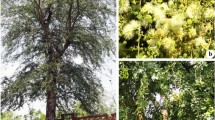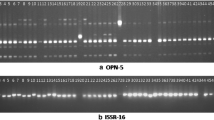Abstract
Knowledge of genetic relationships among genotypes is essential for the effective utilisation of germplasm, especially for poorly characterised species. Random amplified polymorphic DNA (RAPD) analysis provides a quick and reliable method for resolving genetic relationships. Although Cucurbita moschata Duch, also known as tropical pumpkin, is one of the most important vegetable crops in Africa, being adapted to a wide range of climatic and soil conditions, it is a scientifically neglected species. The objectives of this study were to (1) analyse the amount of genetic diversity inC. moschata landraces grown in south-central Africa and (2) classify the landraces to assist in selection of parent genotypes for improvement of fruit characteristics. Cluster analysis, based on 39 polymorphic and 105 monomorphic DNA fragments amplified by 16 primers, was used to show relationships among 31 genotypes obtained from Zambia and Malawi. The analysis revealed four clusters, with genotypes from Malawi mainly clustering in three clusters while all genotypes from Zambia and three from Malawi clustered in one cluster. The pair-wise mean genetic distance was 0.32 ± 0.04 for samples from Malawi and 0.26 ± 0.04 for samples from Zambia. The possible application of the resulting classification in breeding of C. moschata is discussed.
Similar content being viewed by others
References
Dos Santos, J.B., J. Nienhuis, P. Skroch, J. Tivang & M.K. Slocum, 1994. Comparison of RAPD and RFLP genetic markers in determining genetic similarity among Brassica oleracea L. genotypes. Theor Appl Genet 87: 909–915.
Garcia-Rodriguez, E., I. Alvarez & R. Lozano, 1996. Random amplified polymorphic DNAs (RAPDs) as markers to determining genetic relationships among Cucumis melo L. genotypes. Cucurbitaceae 96: 186–193.
Gower, J.C., 1966. Some distance properties of latent root and vector methods used in multivariate analysis. Biometrica 53: 325–338.
Gwanama, C. & K. Nichterlein, 1995. Importance of cucurbits to small-scale farmers in Zambia. Zambian J Agric Sc 5: 5–9.
Hallden, C., I.N.O. Nilson, I.M. Rading & T. Sall, 1994. Evaluation of RFLP and RAPD markers in a comparison of Brassica napus breeding lines. Theor Appl Genet 88: 123–128.
Lee, S.J., J.S. Shin, K.W. Park & Y.P. Hong, 1996. Detection of genetic diversity using RAPD-PCR and sugar analysis in watermelon [Citrullus lanatus (Thumb.) Mansf.] germplasm. Theor Appl Genet 92: 719–725.
McDonald, M.B., L.J. Elliot & P.M. Sweeney, 1994. DNA extraction from dry seeds for RAPD analysis in varietal identification studies. Seed Sci Techn 22: 171–176.
Mumm, R.H. & J.W. Dudley, 1994. A classification of 148 maize inbreds: I. Cluster analysis based on RFLPs. Crop Science 34: 842–852.
Obara-Okeyo, P. & S. Kako, 1998. Genetic diversity and identification of Cymbidium cultivars as measured by random amplified polymorphic DNA (RAPD) markers. Euphytica 99: 95–101.
Sneath, P.H.A. & R.R. Sokal, 1973. Numerical taxonomy. W.H. Freeman and Co. San Francisco.
Staub, J., F. Serquen & M. Gupta, 1996. Genetic markers, map construction and their application in plant breeding. HortScience 31: 729–741.
Tanhuanpää, P.K., J.P. Vilkki & H.T. Vilkki, 1995. Association of a RAPD marker with linolenic acid concentration in the seed oil of rapeseed (Brassica napus L.). Genome 38: 414–416.
Tanhuanpää, P.K., J.P. Vilkki & H.P. Vilkki, 1995. Identification of a RAPD marker for palmitic acid concentration in the seed oil of spring turnip rape (Brassica rapa ssp. oleifera). Theor Appl Genet 91: 477–480.
Thormann, C.E., M.E. Ferreira, L.E.A. Camargo, J.G. Tivang, J.G. & T.C. Osborn, 1994. Comparison of RFLP and RAPD markers to estimating genetic relationships within and among cruciferous species. Theor Appl Genet 88: 973–980.
Welsh, J. & M. McClelland, 1990. Fingerprinting genomes using PCR with arbibrary primers. Nucleic Acids Res 18: 7213–7218.
Welsh J., C. Petersen & M. McClelland, 1991. Polymorphisms generated by arbitrarily primed PCR in the mouse: application to strain identification and genetic mapping. Nucleic Acids Res 19: 303–306.
Williams, J.G.K., A.R. Kubelik, K.J. Livak, J.A. Rafalski & S.S. Tingey, 1990. DNA polymorphisms amplified by arbitrary primers are useful as genetic markers. Nucleic Acids Res 18: 6531–6535.
Wilson, H.D., 1989. Discordant patterns of allozyme and morphological variation in Mexican Cucurbita. Systematic Botany 14: 612–623.
Author information
Authors and Affiliations
Rights and permissions
About this article
Cite this article
Gwanama, C., Labuschagne, M. & Botha, A. Analysis of genetic variation in Cucurbita moschata by random amplified polymorphic DNA (RAPD) markers. Euphytica 113, 19–24 (2000). https://doi.org/10.1023/A:1003936019095
Issue Date:
DOI: https://doi.org/10.1023/A:1003936019095




